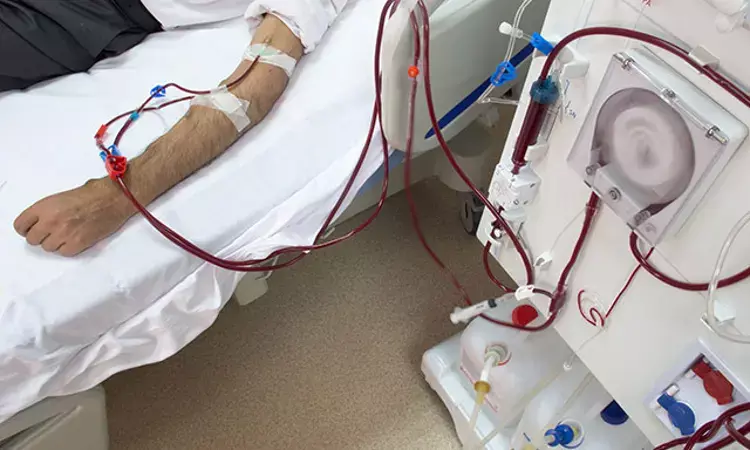- Home
- Medical news & Guidelines
- Anesthesiology
- Cardiology and CTVS
- Critical Care
- Dentistry
- Dermatology
- Diabetes and Endocrinology
- ENT
- Gastroenterology
- Medicine
- Nephrology
- Neurology
- Obstretics-Gynaecology
- Oncology
- Ophthalmology
- Orthopaedics
- Pediatrics-Neonatology
- Psychiatry
- Pulmonology
- Radiology
- Surgery
- Urology
- Laboratory Medicine
- Diet
- Nursing
- Paramedical
- Physiotherapy
- Health news
- Fact Check
- Bone Health Fact Check
- Brain Health Fact Check
- Cancer Related Fact Check
- Child Care Fact Check
- Dental and oral health fact check
- Diabetes and metabolic health fact check
- Diet and Nutrition Fact Check
- Eye and ENT Care Fact Check
- Fitness fact check
- Gut health fact check
- Heart health fact check
- Kidney health fact check
- Medical education fact check
- Men's health fact check
- Respiratory fact check
- Skin and hair care fact check
- Vaccine and Immunization fact check
- Women's health fact check
- AYUSH
- State News
- Andaman and Nicobar Islands
- Andhra Pradesh
- Arunachal Pradesh
- Assam
- Bihar
- Chandigarh
- Chattisgarh
- Dadra and Nagar Haveli
- Daman and Diu
- Delhi
- Goa
- Gujarat
- Haryana
- Himachal Pradesh
- Jammu & Kashmir
- Jharkhand
- Karnataka
- Kerala
- Ladakh
- Lakshadweep
- Madhya Pradesh
- Maharashtra
- Manipur
- Meghalaya
- Mizoram
- Nagaland
- Odisha
- Puducherry
- Punjab
- Rajasthan
- Sikkim
- Tamil Nadu
- Telangana
- Tripura
- Uttar Pradesh
- Uttrakhand
- West Bengal
- Medical Education
- Industry
Rare Case of Primary hyperoxaluria Type 3 with Kidney Failure reported

Primary hyperoxaluria (PH) is a rare genetic disorder that results in an increased hepatic production of oxalate. PH type 3 (PH3) is the most recently identified subtype and results from mutations in the mitochondrial 4-hydroxy-2-oxoglutarate aldolase gene (HOGA1).
To date, there have been 2 cases of kidney failure reported in PH3 patients. Dr Dawn S. Milliner and his team reported about a third patient in whom kidney failure led to a diagnosis of PH3. The case study was published in the American Journal of Kidney Diseases on July 06, 2021.
Case Summary:
Physicians reported about a young man with no known family 9UTIhistory of kidney stones or dysfunction had a history of recurrent urinary tract infection (UTI) beginning at 3 years with subsequent development of daytime enuresis and voiding dysfunction.
- At 12 years: The patient developed a bladder stone and bilateral staghorn calculi. Upon initial metabolic evaluation, the physicians observed hyperoxaluria with very low urinary citrate excretion on multiple measurements for which he was placed on oral citrate supplements.
- At 16 years: A renal scan demonstrated a differential kidney function of 66% on right and 34% on the left kidney.
- At 21 years: kidney ultrasound demonstrated bilateral renal atrophy (each kidney 8.9 cm long) with prominent left renal calyces.
- Further investigation of the hyperoxaluria was not completed as the patient was lost to follow-up observation until he presented at 29 years of age with chronic kidney disease stage 4 (estimated glomerular filtration rate 24 mL/min/1.73 m2).
- At 33 years: Upon subsequent genetic testing, physicians found a homozygous HOGA1 mutation (C.973G>A p.Gly325Ser) diagnostic of PH3 and started hemodialysis 3 times a week.
The patient is currently being evaluated for all treatment options including possible liver/kidney transplantation.
The authors concluded, "All cases of a childhood history of recurrent urinary stone disease with marked hyperoxaluria should prompt genetic testing for the 3 known PH types. Hyperhydration and crystallization inhibitors (citrate) are standard of care, but the role of RNA interference agents for all 3 forms of PH is also under active study."
For further information:
Medical Dialogues Bureau consists of a team of passionate medical/scientific writers, led by doctors and healthcare researchers. Our team efforts to bring you updated and timely news about the important happenings of the medical and healthcare sector. Our editorial team can be reached at editorial@medicaldialogues.in.
Dr Kamal Kant Kohli-MBBS, DTCD- a chest specialist with more than 30 years of practice and a flair for writing clinical articles, Dr Kamal Kant Kohli joined Medical Dialogues as a Chief Editor of Medical News. Besides writing articles, as an editor, he proofreads and verifies all the medical content published on Medical Dialogues including those coming from journals, studies,medical conferences,guidelines etc. Email: drkohli@medicaldialogues.in. Contact no. 011-43720751


